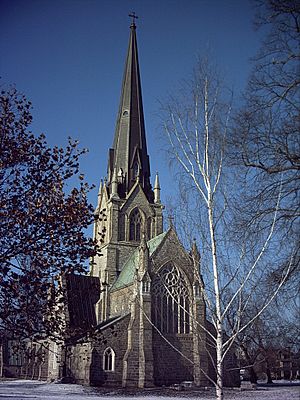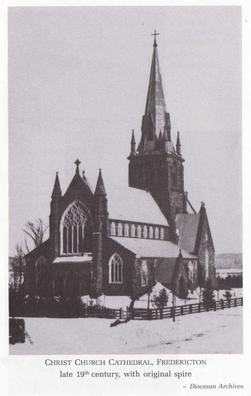Christ Church Cathedral (Fredericton) facts for kids
Quick facts for kids Christ Church Cathedral |
|
|---|---|
 |
|
| 45°57′27″N 66°38′06″W / 45.95750°N 66.63496°W | |
| Location | 168 Church Street Fredericton, New Brunswick E3B 4C9 |
| Denomination | Anglican |
| Website | cccath.ca |
| History | |
| Founded | 1845 |
| Founder(s) | John Medley |
| Consecrated | 1853 |
| Architecture | |
| Architect(s) | Frank Wills, William Butterfield |
| Architectural type | Gothic Revival |
| Groundbreaking | 1845 |
| Completed | 1853 |
| Specifications | |
| Length | 172 feet (52 m) |
| Width | 67 feet (20 m) |
| Height | 60 feet (18 m) |
| Spire height | 198 feet (60 m) |
| Administration | |
| Diocese | Fredericton |
| Province | Canada |
Christ Church Cathedral is a very important church in Fredericton, New Brunswick, Canada. It is the main church for the Anglican Diocese of Fredericton. Building the cathedral started in 1845 and it was officially opened in 1853. The church is built in the Gothic Revival style. This means it looks like old churches from the 1200s and 1300s in England. Its design was inspired by St. Mary's Church in Snettisham, England.
Contents
History of the Cathedral
How the Cathedral Started
The Anglican church area of Fredericton was created in 1845. John Medley became its first bishop. Bishop Medley loved the old Gothic style of churches. He believed new churches should look like those from the 13th and 14th centuries in England. These churches had visible wooden beams, a large area for the choir, and open seats instead of closed-off boxes.
Bishop Medley chose St. Mary's Church in Snettisham, England, as the model for the new cathedral. Before he left England, he hired an architect named Frank Wills. Wills visited St. Mary's and drew detailed plans. Bishop Medley brought these plans with him when he arrived in Fredericton in June 1845.
Some people thought St. Mary's Church was not grand enough for a cathedral. They especially didn't like that its choir roof was lower than the main part of the church. During construction, the roofs were made the same height. Other changes were made to save money or because local workers had limited skills. However, Bishop Medley always made sure the church's details matched other old English Gothic churches.
Building the Cathedral (1845-1853)
When Bishop Medley became bishop in May 1845, he received £1,500 to help build the cathedral. A meeting in Fredericton in June raised another £3,100. Bishop Medley chose a spot next to the Saint John River. He was given 2.5 acres (1 hectare) of land. Work on the site began in August 1845. The first stone was laid on October 15, 1845.
Frank Wills, the architect, came to Canada with Bishop Medley. He supervised the building of the cathedral. He also designed St. Anne's Chapel of Ease. This smaller chapel was built quickly between 1846 and 1847. It was used for services while the main cathedral was being built.
The main walls of the cathedral were finished by the end of 1847. But work stopped because there wasn't enough money. Bishop Medley went back to England in 1848 to raise more funds. Frank Wills had left Fredericton to work in New York City. So, a British architect named William Butterfield designed the choir and tower. Bishop Medley raised another £2,000. The choir and tower were finished in 1849. Medley made the choir longer and the tower taller than Butterfield's original plan. In 1851, Medley visited the United States and England again. He raised more money and received gifts of church furnishings.
Bishop Medley himself designed the cathedral's spire, which was put up in 1851. It was a simple wooden spire covered in zinc. Medley wanted the spire to be 198 feet (60 meters) tall. But because people worried about how strong the church's foundation was, it was built 26 feet (8 meters) shorter.
Cathedral Clock and Bells
The clock in the cathedral is a copy of the famous Big Ben clock in London. The clock face is above the choir and is four feet (1.2 meters) wide. The clock's working parts are in the tower. It was made by Dent of London in 1853 and put in place in 1854. This clock still needs to be wound by hand! Three different people wind it once a month. The weights that power the clock are very heavy. One weighs about 1,000 pounds (454 kg) and the other about 300 pounds (136 kg). To reach the clock and bells, you have to climb a narrow spiral staircase with 51 steps. Then, you climb a very narrow wooden ladder to get to the 15 bells.
The clock's hourly strike stopped in 2007 because neighbors complained about the noise. However, the bells still play the Westminster chime every 15 minutes.
The 15 bells are played using compressed air. A small keyboard is in a closet behind the organ. When a key is pressed, it releases a puff of air. This air pulls a part inside the bell, making it ring. The bells themselves do not move. As of August 2025, only four other churches in Canada use this same way of ringing their bells. One of them is Trinity Anglican Church in Saint John, New Brunswick.
Stained Glass Windows
Most of the cathedral's beautiful stained glass windows were put in between 1850 and 1852. The large east window was made by William Wailes. Its design is a copy of a window in Selby Abbey. It shows Jesus and six of his apostles. This window was a gift from Wailes and Trinity Episcopal Church in New York City.
The west window, made by William Warrington, looks almost exactly like the west window of St. Mary's, Snettisham. The Beer studio from Exeter made the windows in the aisles. Most of these are also copies of windows at Snettisham.
The upper windows, called clerestory windows, are copies of those at Exeter Cathedral. On either side of the west window are two smaller windows. These were put in in 1879 and are the only ones in the cathedral made with gold dust. The last window was installed in 1908 in the choir vestry. It has a design similar to a 14th-century church window.
Fire and Rebuilding (1911-1912)
On July 3, 1911, lightning struck the cathedral. This caused a fire that completely destroyed the spire. The cathedral's eight bells melted. The organ and much of the furniture were also ruined. During the rebuilding, the church's foundation was made stronger. The spire was rebuilt to its full planned height of 198 feet (60 meters).
A rich person named James Hamet Dunn paid for new bells and added seven more. In 1912, 2500 new organ pipes were installed. The cathedral was officially opened again on August 24, 1912. The only part of the tower that survived the fire was the clock, made by Dent Co. in 1853.
Recent Restorations
In the 1990s, the cathedral had a big restoration project that cost $2.5 million. Workers cleaned and repaired the stone, wood, and pews. They also strengthened the masonry at the east end. In 1995, new copper plating and a new cross were put on the spire.
On August 6, 2006, a fire started in the bell tower. The sprinkler system turned on, causing water damage to the choir area. The church was closed for several months while repairs were made.
A National Historic Site
In 1983, Christ Church Cathedral was named a National Historic Site of Canada. This means it's a very important place in Canadian history. It is considered one of the best examples of Gothic Revival church architecture in Canada. Its design influenced many other churches built in Canada during the 1800s.
Music at the Cathedral
The cathedral has a large organ with four keyboards. It was built in 1957 and updated in 1981. This organ replaced an older one that was installed after the 1911 fire.
There are two choirs at the cathedral. An adult choir sings for the main Sunday services and monthly evening prayers. There is also a contemporary choir and band that plays music for a more informal Sunday morning service. J. Thomas D. Gonder is the current organist and director of music.
Leadership
The main leader of the cathedral is called the Dean. As of September 2024, the Dean is Geoffrey M. Hall. He is the only paid priest at the cathedral. Other staff members help the Dean with the church's activities. These include a music director, office administrator, Christian education director, and a full-time caretaker. There are also retired priests who help out as volunteers.
Christ Church Cathedral is unique because it is the only cathedral in Canada that is not also a regular parish church. It has its own rules for how it operates. The cathedral is governed by the "Bishop and Chapter." This group includes people elected by the church members and others chosen by the Bishop of Fredericton.



